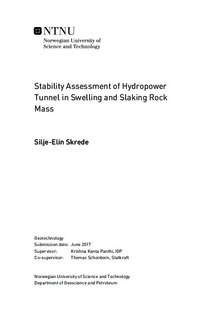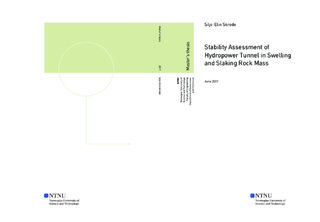| dc.description.abstract | Chile has a favorable topography for hydropower with the Andes mountain rising along the eastern border of the country. La Confluencia is a 158 MW run of the river plant located in the Tinguiririca Valley approximately 150 km south of Santiago. Parts of the two water tunnels are situated in a rock formation, locally known as Coya Machalí, where problems with expansive rocks have been encountered. Typical problems start out as hairline cracks in the shotcrete which may progress to more serious problems. Deterioration of the rock mass has also been observed. The free flow Portillo tunnel was finished in 2011. After two years of operations, cracks in the shotcrete were discovered in the right wall in a part of the tunnel. The deformation was about 10 cm at the worst, and related to a weakness zone.
A study about swelling and slaking of rocks have been conducted. The main task has been to assess the stability of the section where the described problems occurred. Thin sections have been studied, and point load strength test and slake durability test have been carried out on samples from the Portillo tunnel. In addition data from construction mapping, several reports and maps from the project have been studied. A field visit has also been carried out.
Method and results of XRD, DTA and tests of swelling potential carried out in earlier work are described. The content of smectite has been confirmed through XRD on ethylene glycol treated samples. Thin sections are difficult to interpret due to a fine grained matrix and alteration of the samples. The result from the point load strength test show that the samples have low to medium strength, while slake durability is low for the weakest sample, while it is high for the others.
The focus of the stability analysis is mainly on displacements associated with the weakness zone. This have been conducted through a semi-analytical approach and a numerical analysis in RS-2. Both show large deformations, but the methods have some weaknesses. In the numerical analysis different material properties have been tested both for the rock mass surrounding the weakness zone, and the zone itself. Special for this type of rock is the time before stability problems occur. The assessment shows that a gradual reduction in rock strength can lead to shotcrete problems. The same displacement can be seen with only weak material in the weakness zone, as when a stronger material combined with swelling pressure is applied. The approach used in the thesis is not suitable to assess the effect of additional support. It is suspected that the material has degraded from the time of excavation, and it is recommended to continue inspections in case of further reduction of rock mass quality. | |

